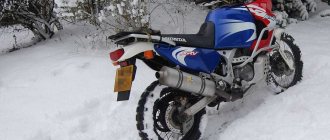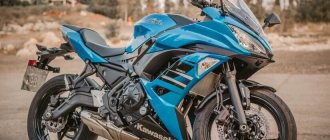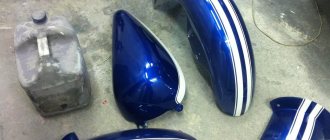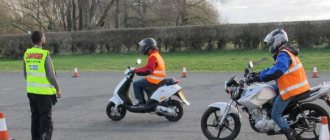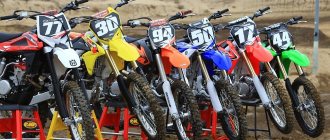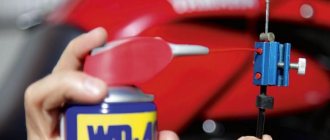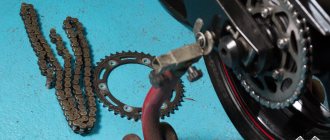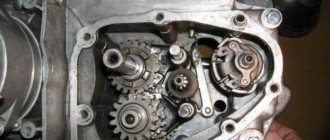Motorcycle equipment is a necessary wardrobe item for any motorcyclist - without properly selected equipment, the chances of survival during critical situations on the road are significantly reduced. Many motorcyclists often neglect to wear equipment, explaining this by the inconvenience or cumbersomeness of protective elements, which is a clear example of its incorrect selection. Remember, the right equipment will only make the driver’s life easier, but this requires knowing how to choose the right equipment for a motorcycle.
Types of motorcycle equipment
There are many protective accessories for motorcyclists, which vary in functionality, level and type of protection. To choose the right model of motorcycle equipment, you must first decide on the class of motorcycle on which the rider will ride and the general characteristics of the terrain. In fact, each type of terrain and each motorcycle requires its own package of protective accessories.
Before ordering a set of equipment, determine the power characteristics and form factor of the motorcycle and analyze the type of terrain where you intend to use the equipment:
- Motorcycle gear for the city
is suitable if you use a motorcycle as your main vehicle. If you are going to ride a bike to work and back on a classic road bike, any universal option will do, and if you have a large chopper or sportbike, you will have to choose a specialized urban option with soft protection; - Cross-country motorcycle protection
is suitable for regular trips into nature or driving over rough terrain. The level of protection of accessories and the pricing policy in this case directly depends on the characteristics of the route section - terrain, road surface humidity and climatic conditions; - Tourist motorcycle equipment
will allow you to travel long distances comfortably. The cost of motorcycle equipment models in this case depends more on the functionality of each accessory rather than on the level of protection.
It is important to know! Having the right motorcycle equipment will not only help you stay healthy in the event of a fall or accident, but will also reduce the impact of external factors on the driver’s body, allowing you to enjoy the ride.
Motorcycle equipment for the city
Urban motorcycle equipment allows you to increase the level of safety of a motorcyclist when traveling in dense traffic conditions. The main requirements for clothing of this class are:
- Elasticity – the equipment should not restrict movement and interfere with the operation of the motorcycle;
- Strength and wear resistance - dense traffic greatly increases the likelihood of an accident on the road, especially when operating a motorcycle due to its small size. Urban motorcycle equipment must have reinforced rigid inserts that protect the musculoskeletal system from fractures, as well as shock-absorbing elements that absorb the impact of a fall;
- Functionality - for comfortable everyday use of a motorbike, the equipment should allow for quick removal and forced temperature regulation.
Based on these recommendations, choose protective accessories based on the power potential of the motorcycle. However, you should not skimp on equipment even if you have a small road bike - remember, your life depends on the quality of the equipment!
Cross motorcycle equipment
Sports motorcycle equipment differs significantly from the urban version, as it involves operation in rough terrain or completely off-road conditions. When choosing protection for motocross or enduro, it is important to consider:
- Security - motorcycle boots should have a fixed frame, and clothing should have reinforced inserts in places exposed to impacts when falling. High-quality equipment should equally protect the body from damage during a direct impact, and evenly distribute kinetic energy during a collision;
- Wear resistance - using equipment on cross-country or enduro leads to a lot of different bumps and falls. All protective accessories must have several points of fixation, and also be wear-resistant - a banal snag on a tree branch is a popular reason for the failure of budget equipment.
Note! During motocross or hard enduro, it is also important to take into account the temperature factor - the equipment must protect against oncoming air flows and at the same time be well ventilated to remove excess moisture and heat from the driver’s body. When choosing off-road motorcycle equipment, it’s a good idea to select high-quality thermal underwear.
Trousers
The best materials for making pants are leather and cordura. These pants are usually reinforced with linings. Leather pants are often attached to a jacket and boots for added protection and comfort.
There are also jeans for motorcyclists - they are thicker than usual, they have a driver protection system, and various inserts in weak spots.
When choosing your first pants, you need to pay attention to the belt; it should be in the form of a drawstring, not an elastic band.
Tourist motorcycle equipment
Motorcycle gear for travel differs from the urban or cross-country type primarily in functionality. High-quality models of tourist motorcycle equipment provide:
- Body thermoregulation - the presence of an insulating layer and forced ventilation cells has a beneficial effect on the level of comfort during the trip. Budget equipment is not suitable for long-distance driving - the result will only disappoint the driver;
- Protection from external factors - clothing and shoes should be as water- and windproof as possible. It is important to note here that with increasing speed of movement, the permeability of tissues with moisture only increases;
- Unloading the musculoskeletal system - a long stay in a static position negatively affects the driver’s well-being. Properly selected equipment will prevent the risk of pinched nerves or “sagging” of the limbs and lower back, and will also serve as an additional shock-absorbing layer for soft tissues.
When choosing a touring motorcycle outfit, you also need to take into account the power characteristics of the motorcycle - cruising speed, aerodynamic performance and the presence of protective elements in the form of a windshield or air wings.
Helmet
The most common element of protective equipment for a motorcyclist - most novice drivers often limit the list of protection only to the presence of a helmet, which is fundamentally wrong. When choosing a helmet, you need to understand their classification:
- The integrals are a closed-type monocoque, which includes protection for the chin area and a visor. An integral helmet significantly increases the chances of survival in an accident: the one-piece design efficiently distributes the kinetic energy of the impact, and the chin guard protects the most vulnerable part of the head;
- Modulars – have an integral shape, but provide the ability to detach the chin guard, which increases the practicality of the product. Suitable for use in road conditions, not recommended for purchase by owners of sports or street bikes - if dropped at high speed, the fastenings of the front part of the helmet may break;
- Cross-country – the helmet form factor is designed specifically for off-road conditions. Among the features that stand out are the reinforced part of the chin and the absence of a visor, which is replaced by cross-country glasses;
- Helmets are a classic version of a helmet that does not have protection for the face and chin. Not recommended for use on large motorcycles.
Also, if the motorcycle is used on an extreme type of surface, it would not be superfluous to purchase neck protection - a special element that prevents the refraction of the cervical vertebrae during a fall.
Motorized turtle When selecting motorcycle equipment for a beginner, a motorized turtle is a mandatory element of protection. This accessory is a combined chest protection that allows you to protect the driver’s internal organs and musculoskeletal system in the event of a high-speed accident. When choosing turtles you need to consider:
- Dimension – the turtle must sit tightly on the driver’s body and not hinder movement, otherwise the benefit of the equipment is reduced to nothing;
- Number of fixations - the presence of additional fasteners, elastic bands or fastex will have a beneficial effect on both the ergonomics of the turtle and its functionality. The mass of fasteners will allow you to adjust the accessory to suit you, and will also have a positive effect on its wear resistance when sliding on asphalt;
- The presence of ventilation channels - in a complex motor turtle, passive ventilation allows you to reduce sweating and regulate body temperature. In the case of using modular turtles, the absence of air ducts is not critical, however, such models have more unprotected areas.
Combined torso protection in the form of a motorcycle turtle is a panacea for owners of sports or naked bikes. In other cases, with a non-aggressive driving style, you can give preference to motorcycle jackets.
Equipment
There should be protective equipment, but for some reason many people think that it should be universal both for long-distance travel (when the journey takes several days) and for a 10-minute commute to work. Based on personal experience, I want to describe personal observations of its different types. I don’t claim originality or the ultimate truth, but I was prompted to write this post by another conversation with a newcomer when discussing the necessary equipment for the city.
After 5 seasons of urban motorcycling, I would like to share my experience and highlight the basic equipment urban be able to quickly change the body thermoregulation settings in the equipment. We can be on a motorcycle for only 20 minutes and feel comfortable, but then sit indoors for 2 hours and sweat like crazy. Or stand in a dead traffic jam at +35 under the scorching July sun, but on the same day return home after rain after 12 at night at a temperature of +15. 2. Helmet with pin-lock and built-in sun visor. Constantly wearing glasses under a helmet is not always convenient on short trips, and after rain or in the cold, opening the visor at every traffic light to avoid fogging is simply inconvenient. 3. A little less protection (compared to sports), but more convenience. The rule is that uncomfortable equipment is often left at home, and not the most protected, but comfortable equipment is worn every day. It is also more comfortable to have as civilian an appearance as possible in your clothing. Let's leave the sports equipment for the track. 4. Textiles, jeans (with Kevlar) and membrane - the best that can be for the city. They breathe and are very practical.
Motorcycle helmet. Options: integral, jet 3/4, modular. — I highly recommend taking an integral with a pin-lock, as well as good ventilation of the head and the ability to leave a thin gap without covering the visor completely - for microventilation. Since there are road and sports intergals (the difference is that in a sports helmet the visor is installed higher than usual with a higher chin - convenient for looking directly at a shrimp landing), the latter have problems with ventilation at low speeds and visibility to the instrument panel and underfoot when parking. There are many models of integrals and they are the easiest to choose. A good format for the cold season. I reviewed my HJC IS-17 here.
— For law-abiding riders, we can recommend a 3/4 format helmet. Excellent ventilation, many shapes and different designs. The disadvantage is of course the openness of the chin, but for low speeds the protection may be sufficient. It’s not for nothing that in Europe most of them travel in cities on a scooter. After the 3/4 season I can’t ride in the integral because I feel like I’m suffocating. A good format for the hot season. I chose a helmet with built-in glasses and a full-face tinted visor.
— A modular helmet is heavier and more expensive, but it combines the advantages of both helmets and, in my opinion, is best suited for the city. Poor choice among manufacturers. A good format for any time of year. In the future I plan to switch to only this one. There is one note - with the “chin” raised, the wind flow from your motorcycle wind protection can create wild discomfort in terms of noise and resistance. This is usually a problem with mid-height windshields - this was not observed on a naked bike or a full-bodied tourist.
Motorcycle jacket. Options: turtle, leather, textile. — Turtle is not the best option for the city. I have heard many times from friends: “I bought it, wore it a couple of times, and it’s in the closet.” There are problems both with ventilation - it seems to be ventilated, but it floats and rubs against the fastenings to the body, and with protection - it is still intended for forests and enduro, when falls happen on the ground or against trees. Suitable for a civilian leather jacket and a turtle jacket underneath. Better than without protection, but too inconvenient to wear every time. — For a leather jacket, perforation and ventilation valves are important for the hot season and a warm lining for the cool season. I consider the peculiarity of the skin to be the ability to not be blown through and to be “saturated” with temperature. For example, in disgusting humid weather below +10, after 30 minutes the skin becomes damp and cold, and you actually begin to freeze even more. And vice versa - in the heat of the sun it gets so hot that even in the shade it continues to bake the body with a kind of heat. For me, leather gear always makes a difference on long rides, but in the city I use a short Dainese jacket with a warm lining and which has 2 vents on the chest for cross-flow. Comfort mode +5..+25 with lining and +18..+33 without it. Why do I know exactly the temperature - there was a thermometer on the dashboard and I constantly noticed changes of a couple of degrees and the sensations from its change throughout the trip.
— As for a textile jacket, I can say that this is the most versatile option, since they use a multi-layer structure. Typically, tourist jackets use 3 layers - base with ventilation, windstopper and insulation. Yesterday we rode in this jacket at +5 and it wasn’t cold. By removing the inner layers in the heat, there is more space under the jacket, the wind flows better and ventilates through the valves.
— Separately, I would like to highlight jackets with the so-called “cabbage” structure, when part of the front membrane is removed from a regular jacket and it becomes a full translucent mesh, but retains all the protection on the sleeves, shoulders and back. In this mode I drive at +35 and don’t even sweat. Once I didn’t take the removed layer and at +21 I froze to the point of trembling in my body, it seemed like I was eating in just a T-shirt. Comfort temperatures +5…+20 (with insulation), +15…+28 (base layer) +22…+35 (mesh). Removing one layer takes about 2 minutes, and this process is very annoying, so this is the biggest drawback of this “cabbage”. The photo shows how the mesh is illuminated in the ventilation format itself.
I would also like to say something about the leather jumpsuit. I rode both in separate and in one piece. Since it should be tight, the perforation does not help much. It takes a long time to put on and take off, you start to sweat in traffic jams, and at speed the skin doesn’t sell well. From experience, it is impossible to drive in it during the day at temperatures above 25. Not the best choice for the city in the home-work-home mode. I felt best in it when driving around the city at night in the summer, as well as on a long trip for 1 day.
Moto gloves. Long or short? The only piece of equipment that in my opinion should be made of leather. Leave textiles for forest and enduro. Long gloves have more protection, but in the city you often have to put on and take off gloves, so I recommend short city models with good palm protection, since this is the first part of the body that touches the asphalt when falling. For hot weather, there are gloves with textile inserts between the fingers that ventilate your hands as you move.
Motorcycle pants. Civilian pants + knee pads or motorcycle pants with built-in protection. Following the fact that ordinary jeans are washed through after 2 meters of friction on the asphalt, and then our beloved own skin is washed away, then ordinary jeans are not the best and safest option. But it is comfortable and utilitarian. In the absence of an alternative, I think it’s better to wear knee pads under/on your pants than to ride without any protection at all. Legs are the most common victims of road accidents, so I’d rather wear a knee pad over my jeans, and, as is commonly believed, when sliding, the knee pads twist, but at the moment of the first impact with a peak load, it should complete its task. I often remember the post about the guy who hit his knee on the hood of a car that didn’t allow him to pass. After hitting his knee, the car's headlight, grille, fender and hood were knocked out, but apart from a bruise and contusion, he had no injuries thanks to knee pads. Therefore, I advise you to take Dainese Knee V or Acerbis Impact Evo Knee Protectors for the city, which can fit under regular trousers and are quite comfortable.
When slipping or any fall to the side, the thigh most often suffers, so you can wear motorcycle shorts, although they will not fit under every pants, or you can sew thigh protectors into regular pants. But for the city, I think the best option is motorcycle jeans, of which there are many types, but a mandatory part is the presence of Kevlar fabric (has a yellow color) in the area of the tailbone, hip and knee, which will help cope with slippage (everyone has probably seen the test where they pulled a guy in such pants 100 meters on the asphalt and didn’t get worn through).
Good motorcycle jeans look like regular pants, can be worn in the office, have good stretch and can be quite tight so that the knee protection does not rotate. I wear OJ jeans and haven't had any problems in 3 years. The only peculiarity is that due to the multi-layered nature (jeans + Kevlar + lining), it is quite hot in them at +30 and above, since good protection fits tightly and there is no ventilation. For these cases, you could use textile motorcycle pants from travel kits, which, among other things, have ventilation channels.
Motorcycle boots. Tall or short?
— Tall sports motorcycle boots have become the biggest problem in everyday use of a motorcycle - psychologically I can’t ride without them, but staying in them for 2-3 hours at a meeting in the middle of summer looks like torture. On the go, the situation changes, and despite the lack of wind, it’s pleasant to move in them. But this is true up to 28-30 degrees Celsius, above which you begin to feel like you are in an oven. A good choice for night riding and for riding in cold weather. As far as I have noticed, having a slider on the toe greatly changes the appearance, so if you do not rely on turns at the knee, then you can choose without such sliders.
— Low motorcycle boots (not to be compared with motocross shoes, which differ from ordinary shoes only in a harder sole) have become the shoes that I can recommend for the city. If high motorcycle boots still made you think about whether to wear them or not, then in short ones everything is so comfortable that you don’t even want to go out without them, and there’s not even any talk about any sneakers or slippers. For the city, I would recommend any motorcycle boots with ventilation. Ventilation and leakage can be solved with motor shoe covers, but such a need does not arise often. The fact that the boots have ventilation solved the problem of driving in the hottest weather.
Over time, different equipment accumulates and a choice appears depending on the conditions of the trip - precipitation, temperature, the amount of time spent at the final point of the trip in the equipment, and all these options can be mixed. Only then do you understand that there is nothing completely universal, but whether something is suitable for a given task or not. This article did not touch upon the topic of touring, enduronic and track equipment, although there is such, due to the lack of interest among my comrades.
Motorcycle jacket
An alternative to the tortoiseshell are motorcycle jackets, which are made from genuine leather or textiles with the additional introduction of protective inserts. In terms of quality, modern textile options are in no way inferior to leather, but are more ergonomic and allow you to easily adjust the body’s thermoregulation, while leather models are characterized by a long service life and wear resistance.<.p>
When choosing a motorcycle jacket, it is important to take into account its size: the accessory must fit snugly over the entire torso, otherwise the clothing will be easily blown away by the wind. If there are loose areas, the jacket can be sent to a workshop for repairs - sewing a few elastic bands under the lining completely eliminates the problem.
Jacket
For a long time, leather was used to sew jackets - it itself provides good protection. But now textile jackets have appeared, and their quality is constantly increasing, and their prices are lower.
Leather. If you decide to take a leather jacket, pay attention to the thickness of the leather: it should be at least one millimeter. Leather jackets are great for cold weather and can be repaired well. However, such material absorbs liquid well and does not allow the body to breathe.
Textile. Textile jackets are made from carbon, nylon and Kevlar. They have built-in ventilation and protective inserts. There are winter-summer models that have a removable warm lining. The advantages include a wide range of colors - the rider should stand out on the road.
Motorcycle pants and motorcycle jeans
Motorcycle pants provide significant protection for your lower body in the event of a fall. When choosing motorcycle pants, you need to take into account the number of protective elements and the presence of ventilation ducts.
The main rule when choosing motorcycle jeans is the cut: the pants should be loose at the top and tapered towards the bottom. Otherwise, there is a possibility of squeezing the blood vessels on the thighs or getting caught in the gear tab or kickstand when parking, which usually leads to the bike falling.
It is important to know! In the warm season, in case of heavy sweating, to protect your legs, you can purchase armored shorts, which will be used in conjunction with knee pads and motorcycle boots. This set of equipment is perfect for summer training in motocross or enduro.
Motorcycle gloves
When falling from a motorcycle, the hands are the first to suffer, as the driver instinctively tries to protect his face and torso by putting his palms out in front of him. To prevent the consequences of “asphalt disease” on your hands, you need to choose the right gloves: the main list of requirements for selection are tight fit to the surface of the hand and a comfortable grip.
It is important to know! If you use a motorcycle as your main vehicle, you will have to choose gloves for each season.
Knee and elbow pads
Protecting your joints will help you avoid numerous fractures in the event of a fall, but when choosing, you need to choose knee pads and elbow pads that fit exclusively - if the accessories do not fit, their protective properties are useless.
Need to know! Knee pads and elbow pads must be worn exclusively under clothing, and then secured tightly with fasteners. If accessories are on top of clothing, they may move to the side during a fall, which will only aggravate the situation. In case of skin chafing, you can wear thermal underwear under the protective equipment.
Protection
The so-called motor turtle is a frame protection of the upper body, which can be continuous or separate. A good motor turtle will help reduce the level of damage to a minimum or get rid of it altogether. When choosing, you should pay attention to protection in the chest area. There are two types:
- Cross motorcycle turtles are designed to protect against slipping. There are models of full protection or lightweight.
- Road motorized turtles, with the help of foam inserts (in expensive models, honeycombs made of aluminum or titanium are installed) well absorb the force of impact in an accident.
General points: what motorcycle equipment to choose?
When selecting motorcycle equipment, it is important to adhere to some recommendations that will improve the performance characteristics of the protection:
- When choosing motorcycle pants, pay attention to the options that are tapered at the bottom - this will avoid the risk of the pant leg getting caught on parts of the motorcycle after parking;
- When choosing motorcycle jeans, pay attention to the presence of air channels, as well as the possibility of dismantling protective elements. Ventilated jeans allow you to reduce sweating and reduce body temperature, and removable parts allow you to wash them in a household washing machine or quickly replace damaged elements with new ones;
- Motorcycle boots must have a fixed ankle, otherwise there will be no point in purchasing them. If your foot bends freely in the boot, look for another model;
- All protective elements must fit snugly to the body. You can adjust the equipment by hemming several elastic bands, but it is important that the protection does not press on the blood vessels;
- Also, never neglect the functionality of your equipment for the sake of design – it’s not worth it!
- Remember, high-quality equipment is not more expensive, but it is chosen correctly. So try to pay attention to this issue and don’t hesitate to choose your equipment - one day it will seriously help!
Hi all! A friend of mine is planning to enter the motorcycle movement and asked for help with choosing equipment. Well, I decided at the same time to post my thoughts for general discussion. I omitted links to products and options where to buy cheaper so as not to confuse the moderators. Criticism is welcome, share your experience. Important! This review was made for daily road use with an emphasis on long-distance vehicles. There are other accents for sporty and cross-country use of motorcycles.
In short, according to the equipment.
1. Helmet There are: a) integrals
+full protection +easy to attach the camera (a must-have in the future) +huge selection -heavy -poor ventilation -you get tired if you drive for a long time and it’s not very comfortable, how convenient it is is not immediately clear * take it with the installation of a pinlock and immediately install it, this is the second lens, attached from the inside - then the visor does not sweat
* take with a sun curtain, the second visor inside is lowered if necessary, saves in the bright sun, the alternative is a replaceable visor but you will have to change it, you can’t see anything at night * take with good ventilation, the more opening holes for ventilation the better, otherwise you can suffocate * take with With cutouts for the headset (masthev), there should be niches for the speakers inside under the lining. The helmet must fit tightly, otherwise it will be of no use; if you end up attaching the speakers from a headset without recesses inside, then the ears will be ruined. Even with the recess in my speakers, I make them thinner, otherwise they press * all heads are different and the configurations of the helmets are also different, they say if one helmet from the company does not fit, then it’s better to immediately take another one, they seem to have the same blanks for the geometry of the head for all helmets. the lighter the better, but in the end this is the price...
My scorpion exo 510 air presses if I drive for a long time
The deuce took the simpler scorpion exo 390
b) open
+ Awesome, light, ventilated, you can drink water without taking it off. — if you fall, there is a chance of being left without a chin — a camera, if you don’t want to be a teletubby, the only thing possible is this: Sena 10c evo/pro This includes helmets up to ¾
c) transformers/modulars
Here you need to pay attention to reviews, because the design is more complex and can become loose over time. for the protection of xs. I want to switch to such a helmet with the Sena 10c pro headset)) but it’s too expensive.
Verdict - the helmet should fit FIRMLY, not ride on your head, and COMFORTABLE. Just select manually. And yes, cheap noname from China without tests and don’t understand what’s inside like a helmet and I won’t even consider it further. Price: from 15k
1.1 Balaclava. An important piece of cloth. Without it, your ears can be torn off while you're getting into the helmet. In hot weather it can get wet, and in general it’s better to wash it than a helmet. Although there are special anti-odor sprays for helmets/motorcycle boots. In the distance, it's a must-have. When I travel long distances, every day this rag is black with dirt when washed in the evening.
What to pay attention to - there are super light thin synthetic ones - an excellent option for hot weather. There are thicker warm ones. It infuriates me to adjust it while wearing a helmet so that it covers my nose, so I have to make it super tight, otherwise it inside the helmet will then stretch, I don’t know how. In the end, they took the two for a child and are happy as an elephant. And mine are all too big for her. It’s better to take several, sometimes you forget to wash it, and it’s already unpleasant to put it on.
2. Gloves Sometimes they are shortened, sometimes they fit around the wrist. From light to sophisticated with an elastic band sewn into the finger to wipe the visor from water, like windshield wipers on a car. You need to understand what they are for: - a pebble from the road can fly into your hand, this is not just painful, it is traumatic. -when you fall, you can probably grab the asphalt with your hands, so they shouldn’t immediately tear and wear off
I started with furygan fury road
cool, cool, very protected, but they have second gloves inside, and if they are wet, turn this lining out, then you’ll put it back in. They take an extremely long time to dry, it’s damn hot in hot weather.
Switched to furygan camo + heated grips. I don’t even bother with the rain in summer, they dry quickly on me.
Verdict - try it out, they should fit tightly, be ventilated, and have protection at least from stones/bugs from the road.
Price: from 5k
3. boots - Here from slippers to wooden shoes. It's a matter of balancing protection and comfort.
-Must-have protection for the toe and foot, because from experience, mine are scratched, worn out, knocked down in these places - on curbs, etc. -for those who are on the mechanics - boots should be prepared under the gear shift foot - ordinary shoes wear out - it is important to protect the foot from breaking. Our foot bends forward, backward (like pressing a pedal in a car, I’m talking about that) and across when we twist our leg. So, under no circumstances should your ankle get twisted in your boots! Forward and backward should also be limited.
Ventilation is also of great importance. In case of rain, you can wear shoe covers as a last resort, but when your foot burns in your boots, it’s sad.
I seem to have torque d1 out air
yes, through the ventilation holes on the puddles it floods, dense, creaking infection with a hinge. But somehow I wore them out, that I could walk in them for a long time without problems and work with the pedals in a car normally. And it seems to me that the protection in them is excellent. It's been 50k+ 4 years, the snake is chugging, the sole is worn out, but so far they're coping.
I don’t even know what to replace, most likely the same ones or I’ll try something touring, but these are damn convenient.
Verdict: choose legs that are protected from bending and COMFORTABLE! Price: from 15-20k
4. Body protection Here you need protection from impacts (off-road riding + city) and from slipping (track). The turtle will protect ONLY from blows. The jacket must protect against slipping! ordinary fabric is abraded into dust after 30 centimeters on the asphalt.
Options: -turtle + jacket - crappy IMHO, but there are advantages - there are jackets with standard shoulder and elbow protection and then you only need back protection. If you combine a turtle and a jacket, in summer you can leave only the turtle. But taking off several pieces of clothing every time is inconvenient IMHO. -jacket with built-in protection -sport overalls
a) Turtles - there are shells
There are transformers Just back protection:
b) jackets Leather - cool beautiful, good slip resistance, sometimes with holes for ventilation, but I don't know how it dries and in the heat it's hell
Textiles - there are options here. — They come with a membrane, like the lining is so waterproof, IMHO it’s nonsense, because when your whole jacket is wet, you can be dry, but it’s inconvenient, it’s better not to put the membrane inside, but a normal raincoat on top — it’s necessary to have adjustable ventilation holes, all sorts of snakes, pockets, etc. When it's cold we zip up, when it's hot we unfasten. Because driving with a jacket completely unbuttoned is not safe. And I had to do this at +35 in Turkey in a thick jacket. It’s important to understand here that heat stroke is easy to catch and just as dangerous as falling without equipment. Thick jackets have a warm lining - a good thing. I wear this jacket in winter. — a pocket for a smartphone, protected from rain — hanging pockets — it’s convenient in touring cars, a lot of pockets, everything is on you. I'm uncomfortable and scared. When the keys are in my pocket, I imagine what they will do to me if I fall - and I take them out and put them in my hip bag. Maybe I’m being paranoid for nothing, I don’t know. Also, when I’m driving a passenger, it’s convenient for her to put her hands in my pockets and hold on. So it's empty...
At first I came up with two sets of equipment - warm and summer, respectively, so that the protection could be rearranged, then it would be convenient for long-distance travel to have one protection, but different rags. But now I’m leaning towards summer + raincoat. That's how they took the deuce. When it’s cold and I’m warm, we put a raincoat on her and she’s comfortable... It’s hot - I’m sweating, she takes off the raincoat. Moreover, the procedure for changing climate control is quick, right on the road, in 2 minutes. The space has decreased significantly.
I use two jackets: furygan wb 06 tour
And for the heat: furygan genesis mistral evo 2
D3O back protection is purchased separately.
IT CANNOT BE BENDED OR CRUMPLED! cracks.
I took a long time to select it so that it sits comfortably like a glove and doesn’t dangle. Since the protection is inside, it should not move, but sit tightly.
For two we took: alpinestars stella wake air jacket
Verdict: if you take a jacket with built-in protection, the protection should NOT be foam rubber and the jacket should fit tightly. Ventilation is a must! Price: standard jacket + protection from 15k
5. Leg protection Knees, like any other joints, are very expensive to repair. Therefore, protection is a must! Options: -knee pads only (for off-road standards, this is how cross racers race) -on top of them you need motorcycle pants to protect against slipping and I don’t know anyone who would ride like that and equip it all every time. -motorcycle pants with knee protection in the form of foam rubber - this is bullshit, it’s important to understand and BMW has such pants with protection for show. I initially went for BMW, but in the end I took others after trying them on, talking with a consultant and feeling them in person. -motorcycle pants with built-in good protection -motorcycle pants with removable good protection are my choice.
It’s easy to check (just don’t try to mindlessly check it right away) - you fall to your knees on the concrete floor. If it’s uncomfortable and even more painful, imagine what will happen in an accident.
Thigh protection is optional, IMHO not relevant for a quiet ride.
Ventilation is a must. By the way, the couple and I discovered a strange thing - something was blowing between her legs. And if it’s cold, then it’s good, if it’s hot, then it’s good.
I initially raced in dainese d1 evo motorcycle jeans
Now I've switched to dainese drake super air
and I have no desire to switch to jeans. If I change my jacket, if it’s cold or hot, then I don’t wear pants. In extreme cases, I put a raincoat on them, but very rarely. Warmth from the engine and somehow your feet feel less cold...
The protection is removable, and we often take it off when we get somewhere and then go for a walk, but it’s not easy to remove and install. Especially if you don't take off your pants.
Verdict: Defense should not be nonsense and squirm. Removable or not is a matter of operation. If you go to work, definitely change your clothes and shoes. It's easier and more convenient. Price - knees ~5k pants 5k, motorcycle pants norms from 15k
6. Raincoat (optional) It’s like this - if there are no clouds in the sky, someone (me) rides in any weather. In fact, there are only two problems in the rain: - have time to equip/hide as soon as it starts - wipe the visor from drops in order to see something.
Of course, the ergonomics of the motorcycle are also important here. At some speeds, and even at speed, water does not fly towards the pilot. But one way or another, there may be times when you have to go and it rains. So, riding at speed in wet gear is still a pleasure.
Therefore, if there is the slightest chance of getting caught in rain or cold weather, I keep a raincoat with me: jacket, pants, shoe covers, gloves (if there is no heated handles, be sure to use at least medical ones to wear under wet gloves)
There is really only one requirement for a raincoat - volume. It should not occupy the floor of the trunk. By the way, I had the first one and was almost proud to ride
it’s cool, cheap, a bunch of cormans (it’s not clear why), a belt, but the space it takes up is just a nightmare.
They took the deuce
It’s gorgeous, I carry it with me and always wear it myself with pleasure.
Total - minimum volume when folded - cheap (they tear and are a consumable, the first one is already full of holes, the shoe covers generally died in one long distance, the second one already in two months - the snake broke at the bottom, not critical but a fact) - ventilation is desirable (as in a hyperbow it is not cast, the fabric is overlapping) - preferably bright, in the rain you can’t see anything
Price: from 7k for the whole set
7. Headset (must-have) An alternative to putting a smartphone on the steering wheel is dangerous, IMHO, believe my experience - it’s easy to get distracted by a smartphone and get into an accident in a car, and even more dangerous on a motorcycle, I’m actually against it. And without a navigator and arrows (warns about cameras) it is impossible to drive. Therefore, you need to somehow transfer sound from your smartphone to your ears.
Options: -Put huge speakers on the steering wheel so everyone around can hear. Let's leave it to the minorities. -Connect with a wired headset in droplets - have mercy on your ears. but I didn’t just travel like that, and you definitely need to have a reserve with you on a long-distance trip if the wireless one dies. -Wireless motorcycle headset: It is important to understand whether there will be a need for intercom in the future (other pilots or passengers will need to talk to other headsets). If so, then you need to take a headset that can transmit sound from a smartphone against the background of the intercom. Namely, to hear both the navigator and another headset. Of the adequate cheapest ones, only Sena 5S can do this. Important! When choosing, read the manual for the headset rather than listen to reviews. If there is no need for an intercom, you can take any one.
I used Midland BTX1 PRO - it died
then Midland BTX1 FM (on Ali it costs a penny in a set of 2 pieces, but I just needed an intercom) and discovered that both the intercom and the smartphone essentially did not work.
and switched to Sena 5s - the sound is amazing. The smartphone and intercom work at the same time, but the intercom starts to stutter. Not critical, but still. All options are more expensive - these are the bells and whistles of the intercom - range, technical capabilities of the radio...
Price: from pennies to Ali.
8. Camera - recorder (optional).
For what? - in the event of an accident/accident/dangerous situation, have the opportunity to review what is happening - make memorable videos to review on a cold winter evening when withdrawal
So, in addition to the quality of video recording and all that, the question is - how to isolate the necessary piece of video from the recording? Car recorders have a button for recording a video fragment in an indelible area. On motoregics I found this option only on two, I don’t remember exactly which ones. All other action cameras write stupidly until the memory runs out, or overwrite in a circle until you stop! Therefore, either keep this in mind and be prepared to scroll through all your videos later (you’ll get bored quickly) or take it with the Regik or GoPro function - it has the option of setting tags on the video. Something happened - you pressed a button - and there will be a mark on the video that is then easy to find.
The second important point is stabilization. Without normal stabilization, the video will be jerky, be healthy.
The third point is resolution. There is no point in recording more than 1980, it will take up a ton of space and there is nowhere to view it. BUT if this is the maximum format, then the camera will work at the limit, heat up, and freeze. I took 4K to write in 1980 and at 60 frames per second.
The power supply is also important; usually the battery lasts for an hour ±. Accordingly, you need to have spare batteries and a docking station to charge them, plus the ability to supply external power from the motorcycle. I’ll share my experience - it’s super convenient to put USB in the case. I tried tracking when the battery ran out and changing it to charge it, but it was a chore. Powering the cable from the steering wheel to the camera (there are motorcycle boxes that are waterproof with a hole for charging an action camera) is just an option.
A long wire (1.2 meters) from under the seat between the legs is a normal option, that’s how I drive (the only important thing is to make sure that the connector doesn’t get wet, I melted the sjcam like that, I’m driving and smelling something melting...) you can, if it’s really dumb, put it under your jacket so as not to I telescoped and made a reserve in length so that when I forgot about it, I wouldn’t tear it out with the meat. There are exotic options for a power bank in your pocket or a hanging battery for your neck or a helmet.
I started with the SJCAM SJ8 Pro - an excellent work machine, but two years later the screen cracked and the video from it is still stored as dead weight, unwatched.
Currently using Hero 8
Plus you will need a flash drive. Top speed and as much volume as possible. When traveling long distances, since I have no time to view and delete videos, and sometimes I don’t have time to transfer them to a laptop, I take two 256 gigs and a couple of terabyte hard drives. Fortunately, on GoPro, viewing and deleting unnecessary videos does not take a lot of time and difficulties.
In principle, there are plenty of cameras in Moscow, and if necessary, recordings can be found, but in general you need a registry. Anything happens on the road.
Price: camera from 7k, flash drive from 2k + for small items you can probably get around 10k.
9. hip bag (must-have) What I carry with me: Documents, Euro protocol form, small power bank, keys, medical mask (fucking Covid), bandana (you can wet it in the heat and put it on your neck, wipe something, cover your head from the heat under the sun, wrap your neck, wrist if it’s cold...), sometimes receipts, a parking card, garbage if there is no trash can nearby, wet wipes to wipe the visor.
You can stuff it into your pockets, but it’s inconvenient. Plus, sometimes you need to remove the camera or headset from the helmet to recharge it, and so as not to carry it in your hands, you can also throw it in a hip bag. If you're walking on a trip, it's convenient to use it as a purse. There are bags that can be worn on the hip, on the belt, or over the shoulder. There are different sizes - choose according to your needs.
I use the niche nmo 2221, it’s not very comfortable, it slips sometimes, it doesn’t easily attach to all pants, but it’s a roomy pocket and can be worn on a belt, sometimes convenient with shorts when going for a walk in between trips.
Price: from pennies to Ali.
10. smart watch (optional) If you have a headset, you can receive calls, great. But what to do when notifications beep at you all the way? This is also inconvenient in the city, when sometimes the journey around Moscow can take an hour and during this time everything can change. And in the distance. Stopping constantly, taking off your glove, taking out your phone, looking at what the hell is going on there is boring. It helps to customize notification sounds, but it’s also not a solution. Accordingly, we need a watch that will display caller notifications and that can be operated with gloves.
In general, this is a separate big topic as with motor navigators, but I’ll tell you about my experience:
Almost all of them are designed for a touch screen, which is not convenient; mechanical control is required. I started with SAMSUNG gear s3 frontier. Great navigation wheel, but stupid operating system.
So I switched to android wear - LG Watch Urbane 2nd Edition.
Their strap died, they got a new processor for the watch and I switched to Fossil gen 5.
Excellent watch, replaceable strap, whichever you want, I took a stretchable one on Ali so that it could be easily put on over a jacket and on your hand.
The wheel that allows you to open notifications at a traffic light, when you turn your wrist, it also turns on and shows the latest notification, in short it’s convenient. We fell unsuccessfully, broke the screen, switched to similar but in a different form factor falster skagen 3.
Now a new processor has come out again, which is even faster and less energy-intensive, but the only option is TicWatch Pro 3 without a wheel and it will not be convenient to use.
On the previous 3100 processor there are still plenty of options, but without a speaker, I was looking for ones that I could talk through. It's convenient in the car.
Price: from 15k
